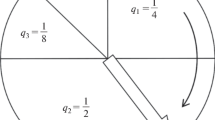Abstract
We develop here a new class of stochastic models of gene evolution in which a random subset of the 64 possible trinucleotides mutates at each evolutionary time t according to some time dependent substitution probabilities. Therefore, at each time t, the numbers and the types of mutable trinucleotides are unknown. Thus, the mutation matrix changes at each time t. This pseudochaotic model developed generalizes the standard model in which all the trinucleotides mutate at each time t. It determines the occurrence probabilities at time t of trinucleotides which pseudochaotically mutate according to 3 time dependent substitution parameters associated with the 3 trinucleotide sites. The main result proves that under suitable assumptions, this pseudochaotic model converges to a uniform probability vector identical to that of the standard model. Furthermore, an application of this pseudochaotic model allows an evolutionary study of the 3 circular codes identified in both eukaryotic and prokaryotic genes. A circular code is a particular set of trinucleotides whose main property is the retrieval of the frames in genes locally, i.e., anywhere in genes and particularly without start codons, and automatically with a window of a few nucleotides. After a certain evolutionary time and with particular time dependent functions for the 3 substitution parameters, precisely an exponential decrease in the 1st and 2nd trinucleotide sites and an exponential increase in the 3rd one, this pseudochaotic model retrieves the main statistical properties of the 3 circular codes observed in genes. Furthermore, it leads to a circular code asymmetry stronger than the standard model (nonpseudochaotic) and, therefore, to a better correlation with the genes.
Similar content being viewed by others
References
Arndt, P.F., Burge, C.B., Hwa, T., 2002. DNA sequence evolution with neighbor-dependent mutation. In: RECOMB’02, Proceedings of the 6th Annual International Conference on Computational Biology, pp. 32–8.
Arquès, D.G., Michel, C.J., 1993. Analytical expression of the purine/pyrimidine codon probability after and before random mutations. Bull. Math. Biol. 55, 1025–038.
Arquès, D.G., Michel, C.J., 1995. Analytical solutions of the dinucleotide probability after and before random mutations. J. Theor. Biol. 175, 533–44.
Arquès, D.G., Michel, C.J., 1996. A complementary circular code in the protein coding genes. J. Theor. Biol. 182, 45–8.
Arquès, D.G., Fallot, J.-P., Michel, C.J., 1998. An evolutionary analytical model of a complementary circular code simulating the protein coding genes, the 5’ and 3’ regions. Bull. Math. Biol. 60, 163–94.
Bahi, J.M., Michel, C.J., 2004. A stochastic gene evolution model with time dependent mutations. Bull. Math. Biol. 66, 763–78.
Berstel, J., Perrin, D., 1985. Theory of Codes, Academic, New York.
Chazan, D., Miranker, W., 1969. Chaotic relaxation. Linear Algebra Appl. 2, 199–22.
Ermolaeva, M.D., 2001. Synonymous codon usage in bacteria. Curr. Issues Mol. Biol. 3, 91–7.
Frey, G., Michel, C.J., 2006. An analytical model of gene evolution with 6 mutation parameters: an application to archaeal circular codes. J. Comput. Biol. Chem. 30, 1–1.
Fryxell, K.J., Zuckerkandl, E., 2000. Cytosine deamination plays a primary role in the evolution of mammalian isochores. Mol. Biol. Evol. 17, 1371–383.
Galtier, N., 2001. Maximum-likelihood phylogenetic analysis under a covarion-like model. Mol. Biol. Evol. 18, 866–73.
Goldman, N., Yang, Z., 1994. A codon-based model of nucleotide substitution for protein-coding DNA sequences. Mol. Biol. Evol. 11, 725–36.
Jukes, T.H., Cantor, C.R., 1969. Evolution of protein molecules. In: Munro, H.N. (Ed.), Mammalian Protein Metabolism, pp. 21–32. Academic, New York.
Kimura, M., 1980. A simple method for estimating evolutionary rates of base substitutions through comparative studies of nucleotide sequences. J. Mol. Evol. 16, 111–20.
Kimura, M., 1981. Estimation of evolutionary distances between homologous nucleotide sequences. Proc. Natl. Acad. Sci. USA 78, 454–58.
Lassez, J.-L., 1976. Circular codes and synchronization. Int. J. Comput. Syst. Sci. 5, 201–08.
Michel, C.J., 2007. An analytical model of gene evolution with 9 mutation parameters: an application to the amino acids coded by the common circular code. Bull. Math. Biol. 69, 677–98.
Michel, C.J., 2008. A 2006 review of circular codes in genes. Comput. Math. Appl. 55, 984–88.
Robert, F., 1986. Discrete Iterations: A Metric Study. Series in Computational Mathematics, vol. 6. Springer, Berlin.
Takahata, N., Kimura, M., 1981. A model of evolutionary base substitutions and its application with special reference to rapid change of pseudogenes. Genetics 98, 641–57.
Tuffley, C., Steel, M., 1998. Modeling the covarion hypothesis of nucleotide substitution. Math. Biosci. 147, 63–1.
Wolfowitz, J., 1963. Products of indecomposable, aperiodic, stochastic matrices. Proc. Am. Math. Soc. 14, 733–37.
Yang, Z., 1994. Maximum-likelihood phylogenetic estimation from DNA sequences with variable rates over sites: approximate methods. J. Mol. Evol. 39, 306–14.
Yang, Z., Swanson, W.J., 2002. Codon-substitution models to detect adaptive evolution that account for heterogeneous selective pressures among site classes. Mol. Biol. Evol. 19, 49–7.
Yang, Z., Nielsen, R., Goldman, N., Krabbe Pedersen, A.-M., 2000. Codon-substitution models for heterogeneous selection pressure at amino acid sites. Genetics 155, 431–49.
Author information
Authors and Affiliations
Corresponding author
Rights and permissions
About this article
Cite this article
Bahi, J.M., Michel, C.J. A Stochastic Model of Gene Evolution with Time Dependent Pseudochaotic Mutations. Bull. Math. Biol. 71, 681–700 (2009). https://doi.org/10.1007/s11538-008-9376-4
Received:
Accepted:
Published:
Issue Date:
DOI: https://doi.org/10.1007/s11538-008-9376-4




